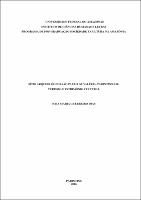| ???jsp.display-item.social.title??? |


|
Please use this identifier to cite or link to this item:
https://tede.ufam.edu.br/handle/tede/5355| ???metadata.dc.type???: | Dissertação |
| Title: | Sítio Arqueológico São Paulo, Valéria/AM: turismo e patrimônio cultural |
| ???metadata.dc.creator???: | Dias, Naia Maria Guerreiro  |
| ???metadata.dc.contributor.advisor1???: | Rodrigues, Renan Albuquerque |
| ???metadata.dc.description.resumo???: | A presente dissertação tem o intuito de evidenciar a relação que os moradores de São Paulo da Valéria/AM mantem com o sítio arqueológico em que residem, a partir do estudo sobre patrimônio cultural e turismo em áreas arqueológicas. São Paulo é uma comunidade tradicional que está assentada no sítio que recebe o mesmo nome, e que foi identificado nas pesquisas arqueológicas de Hilbert e Hilbert (1980) como AM-PT-02. É uma das cinco comunidades que fazem parte do contexto territorial da Valéria/AM, zona rural do município de Parintins. Por suas belezas naturais e socioculturais vêm constituindo-se a quatro décadas como um destino turísticos para cruzeiros internacionais e para alguns turistas nacionais e regionais. Para a construção dessa dissertação, recorreu-se a pesquisa bibliográfica, documental e pesquisa de campo. Tendo uma abordagem de cunho qualitativo e procedimento etnográfico. Os sujeitos foram 10 moradores locais, elencados de acordo com critérios previamente definidos. Para a coleta de dados utilizou-se entrevista semiestruturada, observação participante e diário de campo, com o propósito de identificar as percepções e práticas cotidianas dos moradores em relação ao sítio arqueológico e o turismo local, registrando como eles se organizam para a atividade turística na comunidade amazônica. O estudo revelou que com a inserção do turismo como uma das atividades econômica, a relação dos moradores com o ambiente em que residem tendeu a se modificar, atendendo a situação exterior a sua realidade, vindo a vivenciar diversos conflitos. Pontua-se a representação social que os moradores construíram sobre o turismo e o sítio arqueológico, bem como os desafios enfrentados pelos moradores locais, em se organizar para realizar a atividade. É um trabalho que visou preencher algumas lacunas sobre os processos socioculturais desse contexto amazônico e ao mesmo tempo suscita diversas outros olhares para a complexidade da efetivação do turismo em áreas arqueológicas. Como contribuição à comunidade, sugere-se a efetivação do Turismo de Base comunitária, tendo em vista os dados revelarem que o lugar é propicio para essa modalidade do turismo, sendo este um dos desafios dos moradores da Boca. |
| Abstract: | To present dissertation he/she has the intention of evidencing the relationship that the residents from São Paulo of Valéria/AM maintain with the archeological ranch in that you/they live, starting from the study about cultural heritage and tourism in archeological areas. São Paulo is a traditional community that it is seated at the ranch that receives the same name, and that it was identified in the archeological researches of Hilbert and Hilbert (1980) as AM-PT-02. It is one of the five communities that are part of the territory context of Valéria/AM, rural area of the municipal district of Parintins. For their natural and sociocultural beauties they are being constituted to four decades as a tourist destiny for international cruises and for some national and regional tourists. For the construction of that dissertation, it was gone through the research bibliographical, documental and field research. Tends an approach of qualitative stamp and procedure ethnographic. The subjects were 10 local residents, identified in agreement with criteria previously defined. For the date collection it was used interviews structured participant observation and field diary, with the purpose of identifying the perceptions and the residents' daily practices in relation to the archeological ranch and the local tourism, registering like them is organized for the tourist activity in the Amazonian community. The study revealed that with the insert of the tourism as one of the economic activities, the residents' relationship with the atmosphere in that you/they live tended modifying, assisting the external situation his/her reality, coming to live several conflicts. The social representation is punctuated that the residents built on the tourism and the archeological ranch, as well as the challenges faced by the local residents, in organizing to accomplish the activity. It is a work that sought to fill out some gaps on the sociocultural processes of that Amazonian context and at the same time it raises several other glances for the complexity of the execution of the tourism in archeological areas. The contribution to the community, suggests her the execution of the Tourism of community Base, tends in view the data reveal that the place is propitiate for that modality of the tourism, being this one of the residents' of the Mouth challenges. |
| Keywords: | Sítio arqueológico Patrimônio Cultural Turismo de Base Comunitária Representações Sociais |
| ???metadata.dc.subject.cnpq???: | CIÊNCIAS HUMANAS |
| Language: | por |
| ???metadata.dc.publisher.country???: | Brasil |
| Publisher: | Universidade Federal do Amazonas |
| ???metadata.dc.publisher.initials???: | UFAM |
| ???metadata.dc.publisher.department???: | Instituto de Ciências Humanas e Letras |
| ???metadata.dc.publisher.program???: | Programa de Pós-graduação em Sociedade e Cultura na Amazônia |
| Citation: | DIAS, Naia Maria Guerreiro. Sítio Arqueológico São Paulo, Valéria/AM: turismo e patrimônio cultural. 2016. 128 f. Dissertação (Mestrado em Sociedade e Cultura na Amazônia) - Universidade Federal do Amazonas, Manaus, 2016. |
| ???metadata.dc.rights???: | Acesso Aberto |
| URI: | http://tede.ufam.edu.br/handle/tede/5355 |
| Issue Date: | 26-Aug-2016 |
| Appears in Collections: | Mestrado em Sociedade e Cultura na Amazônia |
Files in This Item:
| File | Description | Size | Format | |
|---|---|---|---|---|
| Dissertação - Naia M. G. Dias.pdf | 2.04 MB | Adobe PDF |  Download/Open Preview |
Items in DSpace are protected by copyright, with all rights reserved, unless otherwise indicated.




